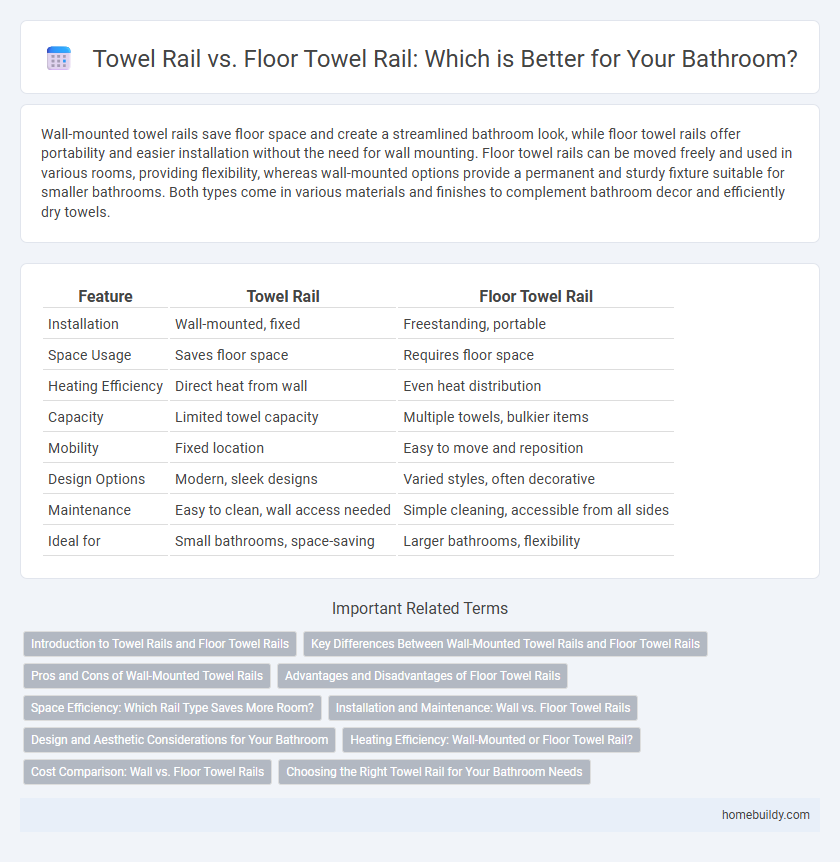Wall-mounted towel rails save floor space and create a streamlined bathroom look, while floor towel rails offer portability and easier installation without the need for wall mounting. Floor towel rails can be moved freely and used in various rooms, providing flexibility, whereas wall-mounted options provide a permanent and sturdy fixture suitable for smaller bathrooms. Both types come in various materials and finishes to complement bathroom decor and efficiently dry towels.
Table of Comparison
| Feature | Towel Rail | Floor Towel Rail |
|---|---|---|
| Installation | Wall-mounted, fixed | Freestanding, portable |
| Space Usage | Saves floor space | Requires floor space |
| Heating Efficiency | Direct heat from wall | Even heat distribution |
| Capacity | Limited towel capacity | Multiple towels, bulkier items |
| Mobility | Fixed location | Easy to move and reposition |
| Design Options | Modern, sleek designs | Varied styles, often decorative |
| Maintenance | Easy to clean, wall access needed | Simple cleaning, accessible from all sides |
| Ideal for | Small bathrooms, space-saving | Larger bathrooms, flexibility |
Introduction to Towel Rails and Floor Towel Rails
Towel rails provide efficient drying solutions by combining functionality with sleek design, often mounted on walls to save space and enhance bathroom aesthetics. Floor towel rails offer a portable and flexible alternative, standing independently without the need for installation, ideal for bathrooms where wall mounting is impractical. Both types optimize towel storage and drying, but the choice depends on space, installation preferences, and design requirements.
Key Differences Between Wall-Mounted Towel Rails and Floor Towel Rails
Wall-mounted towel rails save floor space and offer easy access at eye level, making them ideal for smaller bathrooms. Floor towel rails provide greater portability and often accommodate larger towels or multiple items, but they require more space and can clutter the floor. The choice between wall-mounted and floor towel rails depends on bathroom size, installation preferences, and towel drying needs.
Pros and Cons of Wall-Mounted Towel Rails
Wall-mounted towel rails save floor space and create a cleaner, modern bathroom aesthetic, making them ideal for smaller rooms or minimalist designs. They offer efficient heating and quick drying of towels due to direct exposure, but installation requires secure wall mounting, which can limit placement options and may involve drilling into tiles. Unlike floor towel rails, they do not provide any additional storage or surface area, which some users may find less versatile.
Advantages and Disadvantages of Floor Towel Rails
Floor towel rails offer flexible placement options and can be installed without wall mounting, making them ideal for rental properties or tiled walls where drilling is undesirable. However, they tend to occupy more floor space and may be less efficient at drying towels compared to wall-mounted towel rails due to lower heat distribution and exposure. Their portability allows for easy relocation but limits their heating capacity and stability compared to fixed wall-mounted models.
Space Efficiency: Which Rail Type Saves More Room?
Wall-mounted towel rails offer superior space efficiency by utilizing vertical wall space, freeing up valuable floor area in bathrooms. Floor towel rails, although portable and easy to move, occupy floor space and can make small bathrooms appear cluttered. For maximizing room in compact bathrooms, wall-mounted towel rails are the optimal choice.
Installation and Maintenance: Wall vs. Floor Towel Rails
Wall towel rails offer straightforward installation with mounting brackets that secure directly to studs, minimizing floor space usage and simplifying cleaning around the unit. Floor towel rails require placement on flat surfaces, often necessitating leveling and additional support for stability, making them slightly more complex to install and move if needed. Maintenance for wall-mounted rails typically involves easy access for dusting and wiping, while floor rails may collect debris underneath, requiring more frequent cleaning to maintain hygiene.
Design and Aesthetic Considerations for Your Bathroom
Wall-mounted towel rails offer a sleek, space-saving design that enhances modern bathroom aesthetics with clean lines and minimal visual clutter. Floor towel rails provide a more traditional or rustic look, serving as a statement piece with sculptural elements that complement larger bathroom spaces. Choosing between the two depends on whether you prioritize streamlined functionality or decorative impact in your bathroom design.
Heating Efficiency: Wall-Mounted or Floor Towel Rail?
Wall-mounted towel rails typically offer higher heating efficiency by directly radiating heat into the room and drying towels faster due to better air circulation. Floor towel rails, while providing additional stability and portability, can be less effective in heat distribution as they occupy floor space and may be partially obstructed by furniture. Choosing a wall-mounted model enhances energy use and maximizes room warmth compared to floor-standing options.
Cost Comparison: Wall vs. Floor Towel Rails
Wall-mounted towel rails generally cost less than floor towel rails due to simpler installation and reduced material usage. Floor towel rails often require additional plumbing and support structures, increasing overall expenses. Choosing a wall towel rail can provide a budget-friendly option without compromising functionality and aesthetic appeal.
Choosing the Right Towel Rail for Your Bathroom Needs
Wall-mounted towel rails save valuable floor space and provide efficient heating, perfect for smaller bathrooms or modern minimalist designs. Floor towel rails offer greater portability and often larger capacity, making them ideal for spacious bathrooms or those needing flexible placement. Consider the size of your bathroom, heating requirements, and aesthetic preferences when choosing between wall-mounted and floor towel rails to ensure optimal functionality and style.
Towel rail vs Floor towel rail Infographic

 homebuildy.com
homebuildy.com